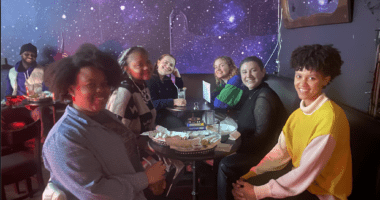Creating lesson plans has to be the most difficult aspect of teaching, and it is especially difficult for Teaching Artists who enter a classroom once a week and usually have only 45 minutes to create an impactful and meaningful lesson. Art, unlike geometry or grammar, has no right or wrong answer. This makes it difficult for a student to learn how to embrace all the liberties that come with creating art, but also difficult for a Teaching Artist to determine when a student has truly got something down. As a Teaching Artist Training & Internship (TATIP) trainee, I have two internships. One is at PS 132 in Washington Heights, and one I just completed at Wingspan Arts/Yorkville Community School (YCS) on the upper east side. The two experiences are vastly different, but when it comes to lesson planning, Teaching Artists go about things in similar ways.
For the past two weeks, second graders at PS 132 have been studying acrostic poems and simile. They began by reading “Winter” by Jan Allison, and were told to find the hidden word down the side of the poem. The teaching artists Elizabeth and Maria continued by breaking down some of the imagery in the poem to a 2nd grader’s level of understanding: “winds whisper with icy lips” means the sound the wind makes is like someone with cold lips whispering in your ear. The students began an acrostic poem where the first letter of each line spells out the word peace. They were given a handout with the word peace going down the page and blank lines, but also with a list of each of the five senses. Students were encouraged to use a different sense for each line.
The following week, students created live similes. After giggling like a mud puddle and dancing like there were ants in their pants, the students added a simile to each line of their acrostic poems. I watched their poems turn from “Paper feels smooth,” to “Paper feels smooth like a Barbie’s hair,” and was once again blown away by the talent these little people possessed.
Penguins see fish jumping into the air like angry birds
Elephants feel soft like a carpet when someone is riding on them
Atlantic Ocean sounds like a whooshing whale
Carpets smell like dogs dirty feet
Eggs taste buttery like a chicken
While it is true that almost no one’s poem was actually about peace, the lines were beautiful, thought provoking and filled with sensory detail. Many students were disappointed they wouldn’t be allowed to work on the poems anymore, but deciding to make it a teachable moment, I told them how even famous writers look back at their work and see things they wish they’d want to change. I told them that that was okay because it means that they’re still trying to improve and grow as writers, advice I’d once received myself by author George Saunders.
I asked Elizabeth how she and Maria determined that two weeks would be long enough to get through this project. She said when creating a lesson plan she times out everything, down to how long her introduction is going to take. As long as she kept checking the time she knew that the poems could be completed in two weeks. I also asked about the worksheets the students were working on, which was something that turned out to be Elizabeth’s own creation. She knew that this age group would have trouble remembering sensory details as they wrote their poems, so she made sure there was a check off list they could refer back to. This might not be necessary with an older group of kids, but for this bunch it made all the difference.
At YCS (my after school internship), students just performed for their end of the semester share week. I had been working with the glee club, something that was totally terrifying because I not only know nothing about music, but also have a terrible voice. In thinking about lesson planning, I realized how much the glee club Teaching Artist, Jennifer, took the mood of the children into planning. Though this class only had nine students, they were quite rambunctious. Taking that into consideration, Jennifer allowed the kids to create a choreographed routine to go along with their performance song, Louie Armstrong’s “What a Wonderful World.” Several times during glee club, I witnessed Jennifer change what we were supposed to be doing, because she realized the kids needed to be doing something different that day.
While it might sound like Jennifer’s approach to lesson planning is the exact opposite approach from Elizabeth and Maria, they’re actually the same method. Both programs modeled their lessons with the student populations first and foremost in their minds. Though Elizabeth and Maria tend to be more structured, and that works for them, it is essential that Jennifer remain flexible. At the end of the day, all everyone wanted was for the kids to enjoy themselves and create beautiful art.
I’ve written a few lesson plans now, but am still getting used to focusing on a younger group of students. I’m still terrified that a class will finish an activity super quick, or never fully complete a project. What I’ve learned is that both of these are okay. As you take the time to get to know your students you can, and should, alter your lessons to best suit their needs. If you do that, you’re guaranteed to have a successful experience and so will the kids.
-Tiffany Nesbit, Writer, TATIP Trainee



